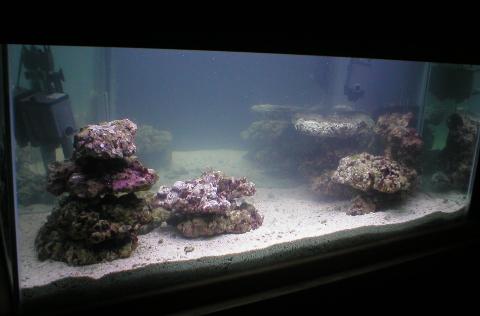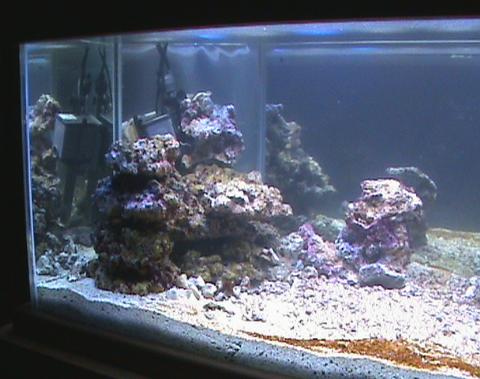A reef is born! From glass box to captive coral reef – part II (adding the liverock)
Having prepared the aquarium and mixed the sea water, it was now time to add the all-important liverock. I used just over a box and this was one of the most expensive aspects of the set up, although considering that it provides virtually all of the filtration and décor it puts things into a bit more perspective.
I used mostly cultured liverock for this tank and as it came with holes pre-drilled it sat very neatly on the acrylic rods that I’d installed for the purpose. In order to increase the range of life introduced and to add variety to the structures, I also added some liverock from a different source and this was also purchased from the Ascot branch. Although it may be cheaper to buy a box of ‘uncured’ liverock, I wanted to use mature rock that had been through the proper curing process, as otherwise my tank would have been first smelly and then subject to peaks of ammonia, nitrite and most significant of all, nitrate.

There is a school of thought that says that uncured rock should be used to mature your system but why go through all the aggro when you can buy it ready cured and save large scale water changes and high nitrates? Buying cured liverock is like buying a pre-matured filter and really makes the difference to the algae blooms in your young system as nutrients settle in to cycles. Good liverock should look reasonably lifeless except for purple coralline algae but will soon spring into life.
Having established that the chosen rock was mature by giving it a good sniff (clean rock smells like the seaside, I won’t tell you what uncured rock smells like but you’ll know its bad!) the remaining pieces were drilled using an 8mm masonry bit in a cordless drill. These holes were then rinsed briefly under the cold tap before being put in place.

I have to say at this point that I’m a big fan of 100% liverock structures but I can appreciate that for some people a scaffolding of cheaper alternatives is necessary. In terms of options, plastics can be a lightweight option but biologically dead, or there are a few rock options to consider. Most of these consist of long-dead marine deposits such as Ocean rock, Tufa or Base rock. Ocean rock is a good standby but is very heavy and dense, taking up lots of water volume and giving little in return. Tufa rock consists of calcified sediments and as such can be a source of organics - often providing good conditions for nuisance algae as the calcium component dissolves, a bit like a growbag for green hair algae. Base rock is mined from areas recently marooned by changing sea levels and is recognisably reef like in origin. Soft enough to drill and porous enough to function like liverock given time, this is a great choice for bulking up your reef if needed.
With the bulk of the liverock added, my aquarium now had filtration, décor and was starting to look like a reef. The open structure would help recreate the habitat that I wanted and was a world away from the classic ‘corals sat on a wall of rock’ that looks more like a greengrocer’s stall than a patch of marine environment.

Having stared at the rock layout, I moved a few bits and pieces around and added some rubble to provide a natural look and shelter for the tiny copepods, amphipods and other wee beasties that complete the ecosystem. Tucked away in the tiny cracks and caves, a population that can escape predation can provide a source of food for both fishes and invertebrates. I collected these tiny bits of liverock over the next few days, by which time the inevitable bloom of diatoms was starting to turn the sand brown. This can be a heart-breaking time in a new reef tank, as this ‘brown algae’ covers everything and grows extremely quickly. As I had a few spare filters available, I added a Fluval 204 external with some phosphate remover and high grade carbon to speed up the process of starving out the brown slime.

I also added three Red Leg Hermit crabs (Paguristes cadenati) to help control the algae and as you can see, they didn’t have to go far to fill their bellies!

So, with the liverock installed and the brown slime burning off some of the nutrients, I sat back and watched life transform my new reef into an ecosystem.



